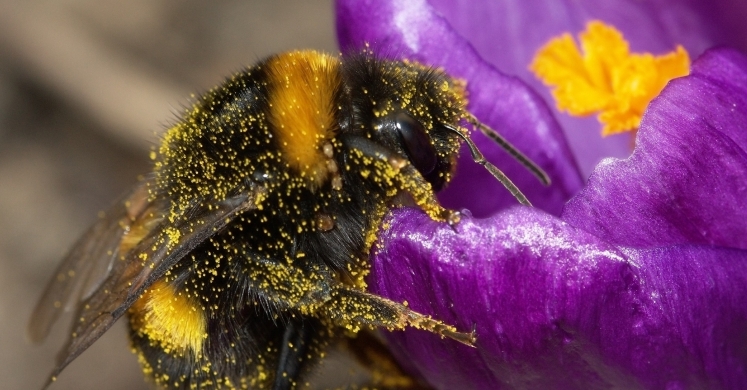Blog

#bioPGH Blog: Pollinator Week!
 A resource of Biophilia: Pittsburgh, #bioPGH is a weekly blog and social media series that aims to encourage both children and adults to reconnect with nature and enjoy what each of our distinctive seasons has to offer.
A resource of Biophilia: Pittsburgh, #bioPGH is a weekly blog and social media series that aims to encourage both children and adults to reconnect with nature and enjoy what each of our distinctive seasons has to offer.
This post includes special contributions by Phipps’ Integrative Pest Management Specialist Dr. Ryan Gott.
If you’re looking for an exciting way to kick off summer, look no further: June 17-25 is National Pollinator Week! A legacy of the US Senate’s attention on pollinators, Pollinator Week was established as a part of a larger effort to bring awareness to the role of pollinators (animals that “pollinate”—move pollen from one plant to another) in our food supply and in our ecosystems. Pollinators have an important job to do, but the details of their work are often a bit fuzzy, so let’s explore, shall we!
What is Pollination?
Pollination is the process of moving a plant’s male reproductive cells (microgametophytes, which are housed within pollen grains) in order to fertilize the female reproductive cells (megagametophytes) on another plant. However, plants can also self-pollinate, which means their own pollen might reach the female structures on the same flower or on a different flower of the same plant.
It is only after pollination that seeds or fruits can grow. We can think of seeds very roughly as the “baby” of a plant, with flowering plants providing protection and housing for the seed in the form of fruit. Some fruits later act as attractants for seed-dispersing animals who will eat the fruit and spread seeds later in scat.
What are Some Examples of Pollinators?
Most of us are familiar with at least some pollinators. Bees are often the most familiar to us as pollinators, and they are both incredibly important and surprisingly diverse, many of which we may rarely encounter or notice. Besides the honey bees and bumble bees, there are sweat bees, mason bees, carpenter bees, leaf cutting bees, mining bees, plaster bees, squash bees, cuckoo bees, and many more! Bees indeed do make excellent pollinators in large part due to specialized pollen-gathering areas called “scopae” (singular “scopa”) that many bees have on either their rear legs or underside of their abdomen. On many bees the scopae are areas of dense, branched hairs that hold pollen as bees press the pollen in. Modified scopae called corbiculae are hairless, polished areas on the hind legs surrounded by long hairs. Each corbicula acts like a pollen basket to hold onto pollen in the honey bees, bumble bees, and a few others.
Aside from the emphasis on bees, a wide variety of taxa act as pollinators including other insects, and even some birds, lizards, and mammals. Butterflies and moths are other famous pollinators, as are some species of ants, beetles, and flies. Hummingbirds are also excellent pollinators, and they are a great example of co-adaptations since they specialize on elongated tube-like flowers that allow the birds’ wings to remain in flight as they collect nectar. On the mammalian front, if you’re a fan of mangoes, bananas or tequila, you will also appreciate the pollination work of bats. Depending on the bat species, they may actually be aiming for either nectar or insects inside the flower, but for the plant, the outcome is the same: a dusty little bat face full of pollen!
Why Are Pollinators So Important?
Without pollinators, most of our food supply would disappear. Globally, at least 75% of our foods come from crops that require pollination, and in the US, approximately one third of our food is derived from the work of bees. Our other native non-crop plants also depend on pollinators to reproduce, so pollinators are essential to maintain much of our shared natural cultural heritage. Luckily, lawmakers have noticed the importance of this role and have increased attention on pollinator species.
Are Pollinators in Trouble?
That depends on us. Though the occurrence of Colony Collapse Disorder (the mysterious disappearance of entire colonies) in honey bees seems to have plateaued, humans are still sorting through how our uses of insecticides, fungicides, herbicides, and other additives to the environment may impact our bees and other pollinators. Also, through habitat loss and fragmentation, our pollinator species have fewer options for homes as we continue to develop natural lands, and introduced exotic species of plants and animals as well as climate change also have complex consequences on our native pollinators.
The Awesome News
You can help! By maintaining a native plants garden and avoiding the use of pesticides, you can protect our pollinator species, and, thus, help protect our food, native ecosystems, and biodiversity. If you are interested in getting started with a garden of your own, don’t forget that you can always call the Dr. Phipps line and leave a question for one of our Master Gardeners.
Continue the Conversation: Share your nature discoveries with our community by posting to Twitter and Instagram with hashtag #bioPGH, and R.S.V.P. to attend our next Biophilia: Pittsburgh meeting.
Resources
Maryland Department of Natural Resources: Common Maryland Bees
National Park Service: Hummingbirds
USDA National Resources Conservation Service: Native Pollinators
IPBES: The Assessment Report on Pollinators, Pollination, and Food Production
USDA Forest Service: Bat Pollination
Fish and Wildlife Service: Pollinators
Photo Credits: Wikimedia Commons user P7r7

